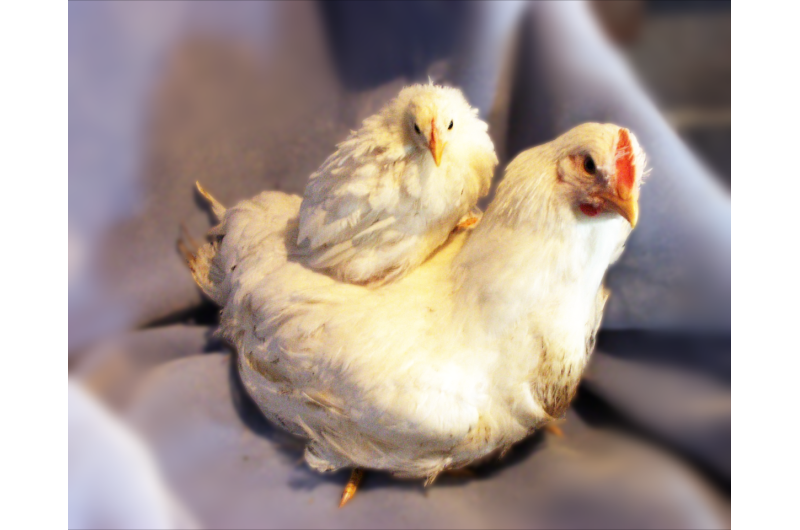Scientists hone in on genetics behind chicken weight adaptation

Prized for their plumpness, poultry farmers have made incredible gains through agricultural breeding programs to maximize chicken size and weight to benefit worldwide consumption, where demand continues to grow the most for any meat.
To aid farmers in their quest to put more plump into the rumps of roosters and hens, scientists have been interested in probing the specific genetics behind the weight adaptation of chickens, better known scientifically as Gallus gallus.
Taking advantage of a special experimentally-bred population, the Virginia chicken lines, Uppsala University scientist Örjan Carlborg has now led an international research to achieve a better understanding of the genetic architecture behind chicken weight.
To explore weight adaptation, Carlborg's research team used two divergently bred lines of White Plymouth Rock chickens, which have been selected since 1957 for high and low body weight, respectively. In their study, they used an advanced intercross line founded by mating the high and low weight lines after 40 generations of selection. The average 56-day body weight in the high-weight line was then 1,412 g compared to that of the low weight counterparts that only weighed 170 g (only about 12 percent of the weight compared to the high weight line).
Using the 15th generation of the intercross line between the high and low weight lines, they identified 20 different genetic loci that when examined explained more than 60 percent of the additive genetic variance for the selected trait.
"Our work with this long-term selection experiment has revealed that different variants at many genetic loci that contribute to the large divergence between the lines selected for high and low weight," said corresponding author Orjan Carlborg. "This is an interesting experimental illustration of how even small and phenotypically homogenous populations, such as the founders of our divergent lines, can harbor many genetic variants that do not diversify the population normally. But still they can allow rapid and extreme adaptations when the population is subjected to intense selection."
They further focused on seven of these genetic hotspots, known as quantitative trait loci, and found that only two could be more finely mapped to a single, well-defined loci; the other five contained linked loci with multiple gene variants or were epistatic. This detailed dissection of the loci contributing to the polygenic adaptations in the Virginia chicken lines does in this way provide a deeper understanding of the genome-wide mechanisms involved in the long-term selection responses.
Although the long-term selection responses for weight were due to many loci of small individual effect, conforming to the assumption of the infinitesimal model of quantitative genetics, the genetic mechanisms within the individual loci were more complex than assumed in this model. The scientists now hope to further explore this chicken model system to further increase our understanding of the genetic mechanisms of body-weight adaptation, and also evaluate how the within-locus complexities will affect predictions of selection responses obtained using the current quantitative models.
"For many, the ultimate aim for studies designed to dissect the genetic architecture of a complex trait is to find the causal genes and mutations underlying the trait," said Carlborg. "It is, but we also need better insights about how to account for contributions by more complex genetic mechanisms to selection-responses, whether in nature and agriculture, for improving predictions of adaptations emerging during long-term selection. Our work with the Virginia chicken lines provides valuable empirical insights to how complex genetic mechanisms have contributed to polygenic adaptation in the past, and it will help us in work to develop better predictive models for the future."
More information: Molecular Biology And Evolution (2017). DOI: 10.1093/molbev/msx194
Journal information: Molecular Biology and Evolution
Provided by Oxford University Press



















